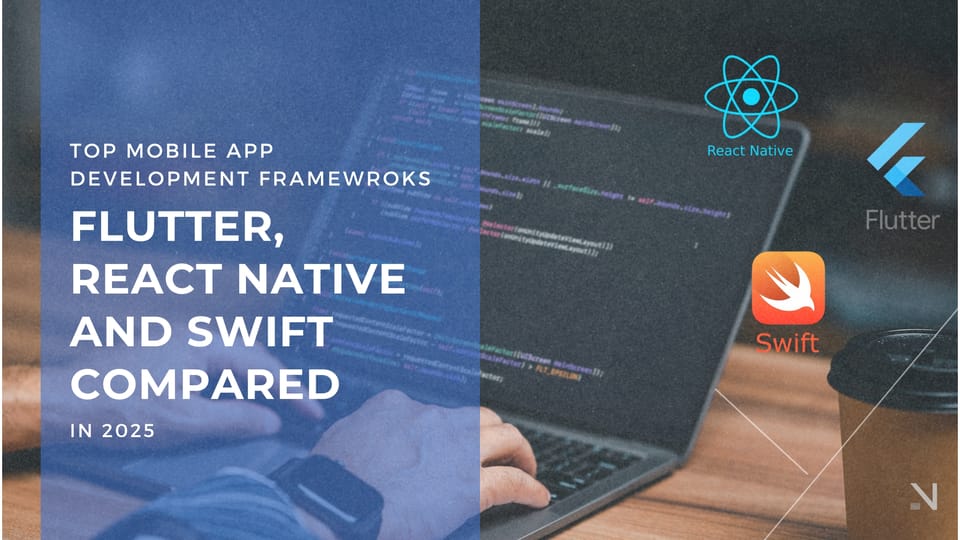Top Mobile App Development Frameworks in 2025: Flutter, React Native, and Swift Compared
Narima Digital •

Mobile app development continues to be a key focus for businesses in 2025, as the demand for engaging and functional applications grows. But with so many frameworks available, which one is best suited for your project? In this article, we’ll compare three of the leading frameworks: Flutter, React Native, and Swift, highlighting their pros and cons to help you make an informed decision.

What Are Mobile App Development Frameworks?
Mobile app development frameworks are tools or libraries that provide a structured environment to build, test, and deploy mobile apps. They allow developers to work faster and more efficiently, offering reusable components, debugging tools, and cross-platform compatibility.
For businesses, the right framework can mean faster time-to-market, reduced development costs, and a smoother user experience. Whether you’re creating a new product or updating an existing one, choosing the right tool is critical to meeting user expectations in a competitive market.
Top Mobile App Development Frameworks in 2025
1. Flutter
Flutter, developed by Google, has made waves in the app development world due to its innovative approach to cross-platform development. Its ability to use a single codebase for both iOS and Android drastically reduces development time while maintaining high performance and stunning visuals.
Why Developers Love Flutter
The Dart programming language is intuitive for many developers, especially those with a background in JavaScript or Java. Flutter’s “Hot Reload” feature speeds up the development process by allowing developers to instantly see the results of code changes, making debugging and iteration seamless. The wide range of built-in widgets gives developers the flexibility to create highly customized and visually appealing apps.
Challenges with Flutter
However, Flutter apps can be heavier in size compared to others, which might be a concern for apps where storage space is a priority. Additionally, while the ecosystem is rapidly growing, it’s still not as expansive as older frameworks like React Native, meaning developers may face limitations when looking for certain plugins or solutions.
Who Should Use Flutter?
Flutter is ideal for startups and small businesses looking to launch minimum viable products (MVPs) or apps that emphasize rich user interfaces and fast iterations. It’s also a strong choice for businesses looking to support Android and iOS users without doubling their development costs.
2. React Native
React Native has been a game-changer since its launch by Facebook, offering a practical and efficient way to build cross-platform apps. It combines the ease of JavaScript with the ability to create native-like experiences, making it one of the most widely used frameworks today.
Key Benefits of React Native
One of React Native’s greatest strengths is its ability to reuse code across platforms, significantly reducing development time and cost. Its robust ecosystem, backed by a global community and corporate support from Facebook, ensures that developers have access to extensive third-party libraries and plugins.
Native modules allow developers to integrate platform-specific features, such as accessing a phone’s camera or GPS, with better performance than traditional hybrid apps. This makes React Native a practical choice for businesses that need cross-platform apps with native capabilities.
Limitations of React Native
However, React Native’s flexibility comes with a cost. Debugging complex performance issues can be a challenge, especially for developers without extensive experience. Additionally, while it provides a good approximation of native UI, achieving pixel-perfect designs often requires extra effort or customizations.
Who Should Use React Native?
React Native is an excellent choice for businesses looking for a cost-effective and fast solution to create cross-platform apps. It’s particularly suited for apps with moderate customization needs and businesses that already have a team experienced in JavaScript.
3. Swift
Swift, developed by Apple, is the go-to language for building iOS apps. While it doesn’t offer cross-platform support, it’s unmatched in delivering high-performance apps tailored for Apple’s ecosystem.
Why Swift Stands Out
Swift’s clean syntax and developer-friendly features make it an attractive choice for creating premium apps. It allows developers to take full advantage of Apple’s hardware and software capabilities, including the latest APIs and iOS updates. The language is also built with safety in mind, reducing common bugs and runtime crashes.
Challenges of Using Swift
The primary drawback of Swift is its exclusivity to Apple platforms, meaning businesses will need a separate solution for Android development. Additionally, for teams unfamiliar with iOS development, the learning curve can be steep. Developing in Swift can also be more expensive due to the need for Apple hardware and licensing.
Who Should Use Swift?
Swift is best for companies focused on delivering apps for the Apple ecosystem, particularly those leveraging features unique to iOS. If your audience primarily uses iPhones or you’re building a high-performance app for premium users, Swift is the way to go.
Flutter vs React Native: Which Should You Choose?
If your goal is to develop a cross-platform app, both Flutter and React Native offer compelling advantages.
- Flutter excels in delivering visually rich and consistent apps, making it an excellent choice for projects with complex UI needs or heavy reliance on animations.
- React Native, on the other hand, offers better scalability for businesses already familiar with JavaScript and looking for a broader ecosystem of tools and plugins.
Here’s a quick comparison to help you decide:
| Feature | Flutter | React Native |
|---|---|---|
| Language | Dart | JavaScript |
| UI Components | Extensive built-in | Relies on third-party |
| Performance | Better for animations | Slightly behind Flutter |
| Community Support | Growing rapidly | Established, larger |
How to Choose the Right Framework
1. Define Your Goals
Start by identifying your target platforms. Are you building for iOS, Android, or both? Apps for a single platform might benefit from native development, while cross-platform apps will be more cost-effective with Flutter or React Native.
2. Consider Your Resources
Assess your in-house expertise. Teams familiar with JavaScript will find React Native easier to adopt, while developers seeking performance and reliability may prefer Swift.
3. Think Long-Term
Consider scalability and maintenance. Apps requiring frequent updates or scalability might benefit from React Native’s large ecosystem, while apps with a smaller user base could excel with Flutter’s speed and flexibility.

Choosing the right mobile app development framework in 2025 depends on your project’s goals, resources, and audience.
- Use Flutter for visually stunning, fast iterations in cross-platform apps.
- Opt for React Native if you need a cost-effective, scalable solution with robust community support.
- Choose Swift for high-performance apps tailored to the Apple ecosystem.
At Narima, we help businesses navigate these choices and deliver custom software solutions. Ready to build your next app? Let's Talk


